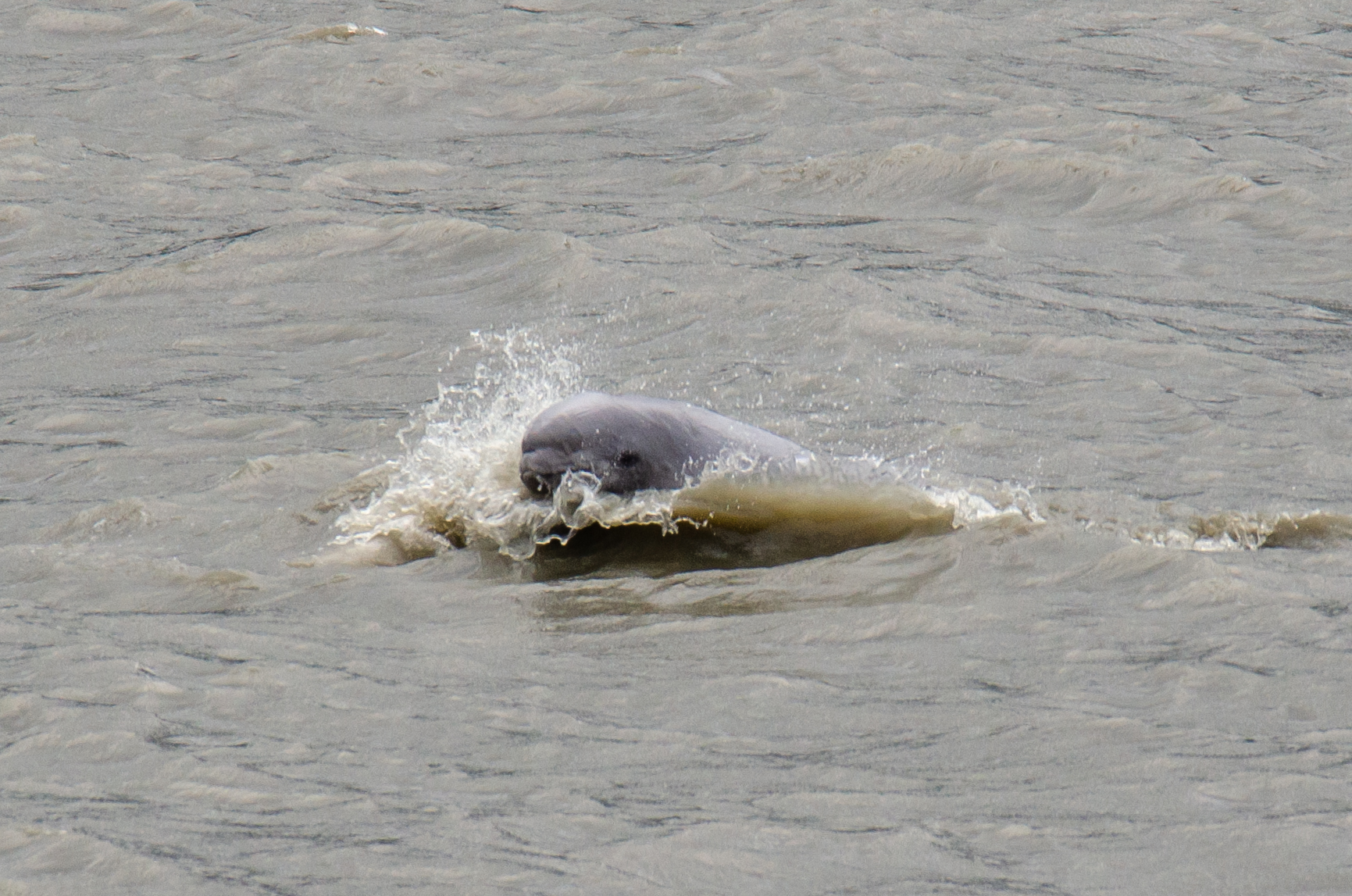
On beings and biomes—beluga whales
By Dawnell Smith
Beluga whales look every bit as darling as the ones depicted in coloring books and the cover of Raffi’s iconic children’s album, “Baby Beluga.” They live up to the way we imagine them. They’re playful and keen, expressive and chatty, and they seem to glide contentedly in “the deep blue sea.”
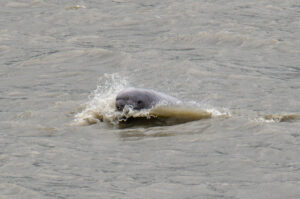
A beluga calf surfaces in the Turnagain Arm. Photo by Madison Kosma.
Of course, Raffi wrote that catchy song after seeing a beluga in captivity, and that perpetual “smile” we find so appealing results from the structure of their jaws, not some general state of joy.
What we do know about these marine mammals who seem so relatable and like us—social, curious, intelligent, able to pass cultural traditions and knowledge from generation to generation—is that they need healthy water to thrive.
Big brains and a lot to say
These smallest of toothed whales get their name from the Russian word for “white,” but they can appear gray, especially when young, and even pink.
They have big, complex brains, with great hearing and echolocation abilities, along with a larger range of vocalizations than other whales. They chirp, trill, whistle, grunt, and click like songbirds, prompting the nickname “canaries of the sea.” They use these sounds to help them hunt, navigate, and communicate with each other and between pods.
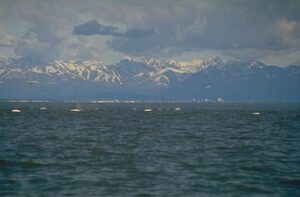
Beluga pod traveling in Cook Inlet. NOAA photo
They gather, travel, and feed in pods, often moving between them, but gatherings of over 1,000 whales have been documented. Female belugas with young often gather together, as do males.
Belugas lack a dorsal fin, which means they can swim seamlessly under ice. They don’t have fused vertebrae like most whales, so they can move their heads back and forth and up and down, letting them more effectively browse for food and direct their echolocation.
Belugas can grow to about 15 feet and weigh up to 3,000 pounds, and they eat what they can find by hunting and foraging for invertebrates like shrimp, clams and mussels and fishes such as herring, cod and eulachon (also called hooligan and candlefish).
Alaska’s beluga whales include three migrating groups known as the Beaufort Sea, Bering Sea, and eastern Chukchi sea populations, along with two populations that stay in specific regions—Cook Inlet and Bristol Bay.
While the beluga whale populations in Alaska seems healthy overall, the Cook Inlet whales experienced a dramatic drop in the 1980s and 90s and have never rebounded.
The whales of Cook Inlet
Just south of Anchorage along the Seward Highway, people use pullouts and vista points along the road and trails to look for Cook Inlet whales swimming and feeding in Turnagain Arm.
They concentrate near river mouths such as Knik Arm, Chickaloon Bay and Turnagain Arm during ice-free months. When salmon runs end and ice forms in the upper inlet, they disperse in smaller groups to deeper waters in the middle and lower portions of the inlet.
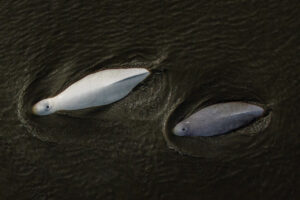
Cook Inlet beluga juvenile and adult. Photo courtesy of NOAA.
Volunteers for the Alaska Beluga Monitoring Program help track these whales. A prior citizen science program between 2008 to 2011 focused on monitoring whales in Turnagain Arm; the current program takes a broader approach by monitoring known feeding areas such as the lower reaches and mouths of several rivers and streams that flow into Cook Inlet. The program gathers information about a whale population that plummeted dramatically and hasn’t recovered.
Michelle Trifari, manager of the monitoring program since 2023, wants people to understand the ecological importance of belugas and how relatable they are to humans, beyond their big brains, talkative nature, and permanent “smiles.”
“Cook Inlet belugas and humans both use resources from Cook Inlet waters and feed on some of the same foods, such as salmon,” she noted. “If belugas are affected by an environmental change such as low salmon runs or pollutants in the water, it is a potential indicator that humans may be affected by those changes as well.”
Most belugas migrate south from the Arctic in winter, but Cook Inlet beluga whales stay in the inlet where melting glaciers make the water silty and turbid. Belugas use upper Cook Inlet during Spring through Fall when it is icefree, but they tend to leave the area in winter as upper Cook Inlet fills with ice. Due to inclimate weather, ice cover, and lack of daylight, it is very difficult for researchers to study beluga habitat use in the winter. A recent study by Castellote et al did confirm that Tuxedni Bay (off the shores of Lake Clark National Park) is a winter foraging location for Cook Inlet belugas.
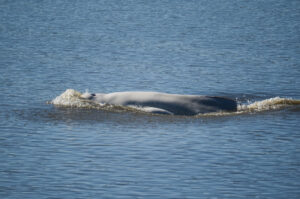
Beluga documented as a part of the Beluga monitoring program. Photo by Madison Kosma.
This genetically distinct population of belugas has adapted to these waters. They’re smaller than other belugas and employ advanced vocalizations to move and hunt for food through low visibility waters.
“They have learned to navigate the extreme tides of upper Cook Inlet,” said Trifari. “Some areas that they forage in at high tide are completely exposed at low tides, so their population has learned when they are able to forage in certain locations and when they need to leave the area as the tide changes.”
The whales were important to the regional Alaska Native subsistence diet in Cook Inlet (Tikahtnu in Dena’ina), and thrived alongside traditional hunters for a long, long time; the estimated population stood at about 1,300 when the Marine Mammal Protection Act was enacted in 1972. The number of whales dropped below 300 by the end of the 1990s and then stayed there. A June 2022 count put the number at 330.
Hunting ceased decades ago because of the decline, and the federal government designated the Cook Inlet beluga population as depleted under the Marine Mammal Protection Act in 2000, and later as endangered under the Endangered Species Act in 2008. Trustees for Alaska fought for and defended beluga whales as endangered, first by petitioning to the National Marine Fisheries Service in 2006 to have the whales listed as endangered, with the protections given to animals with that listing, and then successfully defending that listing in court when the State of Alaska challenged it.
Elevated human and industrial activity has and will continue to impact these whales. Cook Inlet is one of the most industrialized and urbanized places in Alaska, with intense marine traffic, urban waste, and industrial pollution and noise.
Heavy metals and heavy noise
Industrial and marine noise can disrupt pods and make it difficult for belugas to communicate and navigate. Pollutants from industry and city wastewater can cause drops in reproduction and make whales sick. And then there’re the climate impacts on their home waters, food, vulnerability to disease, and much more.
“Heavy metals, persistent organic pollutants and other toxins can accumulate in belugas’ bodies, often affecting their reproductive health and immune systems,” wrote Regan Davey, the Alaska marine representative for Defenders of Wildlife, in an article about how contaminants impact beluga whales. “Studies have shown exposure to contaminants can result in lower reproductive success and higher rates of disease.”
Toxins also harm the fish and other animals that belugas eat.
It’s important to note that Cook Inlet is the only coastal area in the entire country where the oil and gas industry is allowed to discharge extraction contaminants directly into the water. Trustees for Alaska and an array of Alaska groups and Alaskans have fought to change that for over 15 years, but right now, oil rigs continue to dump millions of gallons of oil, drilling fluids, and heavy metal directly into nearshore waters.

Tuxedni Bay in Lake Clark National Park. Photo by Davyd Betchkal.
A proposal for mining an area in the southern Cook Inlet further threatens these beluga whales. The Johnson Tract proposal would put an industrial port in Tuxedni Bay, a refuge and important winter foraging area for belugas. The mine site would be on land owned by the Native corporation, Cook Inlet Region Inc., within Lake Clark National Park and Preserve, and require road access through the park and preserve.
A 2024 petition by Cook Inletkeeper and the Center of Biological Diversity requests that the National Marine Fisheries Service establish a protective zone around Tuxedni Bay. If Park Service grants an access road and a marine ore terminal is built, said the petition, “it would threaten Cook Inlet belugas with nearly every threat detailed in the whale’s Recovery Plan.”
Those threats include habitat loss, food reduction, industrial noise, toxins, and the potential for a catastrophic event that causes expansive harm to the population of whales.
Already the U.S. National Park Service has granted two easements for the proposed road and port, even as those advocating for belugas continue push for protections. Last month, the Chickaloon Village Traditional Council, Cook Inletkeeper, and an Alaska resident joined a Center for Biological Diversity lawsuit challenging a U.S. Army Corps of Engineers’ Clean Water Act permit for mining operations.

Beluga whale flukes. Photo taken as documentation for the monitoring program by Chandera Tolley.
We don’t need gold, that much is certain, but we do need healthy water and beluga whales.
We know industrial and other human activities impact Cook Inlet whales in profound ways, but the small number of whales along with murky waters, tides, ice, and the dynamic ways in which belugas move through their home waters make it difficult to study them. No single factor explains why the population never rebounded or why Cook Inlet whales give birth to calves only once every four years rather than once every two or three years like female belugas in other populations.
Beluga monitoring helps by providing data to researchers and federal agency managers who need that information if they’re going to be able to place measures to reduce the impacts of construction projects near monitoring sites.
“This work is so meaningful to me because it supports the recovery efforts of a species that has so much ecological and cultural importance to those who live on Cook Inlet,” said Trifari.
The monitoring program offers another benefit by bringing folks from the Cook Inlet region into the effort through volunteer shifts at monitoring sites to record beluga sightings. That consistency, collaboration, and care matters profoundly. Cook Inlet belugas can only swim so wild and so free as long as we pay attention and protect their home waters.
This is the sixth in our “Beings and biomes” series. You can find previous articles below:


